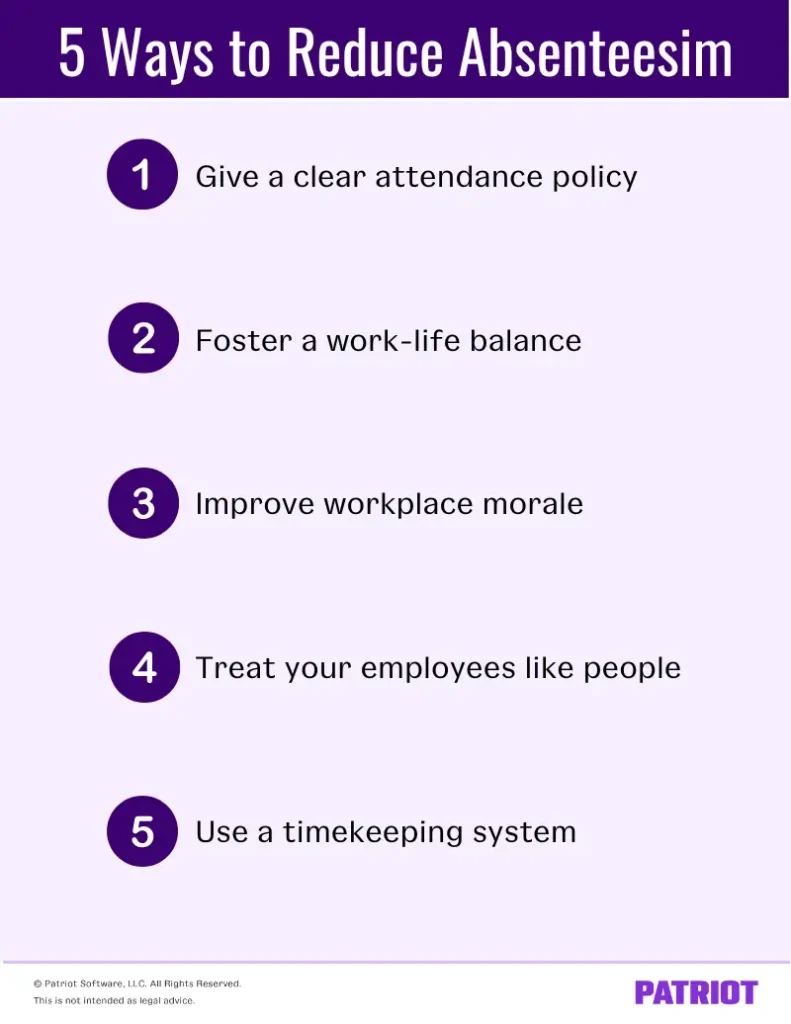It’s a fact of any business: Employees occasionally miss work and absenteeism is going to happen. Sure, absenteeism isn’t always avoidable. But, there are steps you can take to reduce absenteeism in the workplace.
5 Ways to reduce absenteeism in the workplace
Absenteeism is preventable if you’re willing to take a few steps to improve some aspects of your workplace. With that in mind, here are five ways to prevent absenteeism.

1. Give a clear attendance policy
To help reduce absenteeism, create a crystal clear attendance policy.
This isn’t your run-of-the-mill classroom attendance policy from school. Your attendance policy should be specific and let employees know the expectations for their workdays, including:
- Shift times or normal working hours (in person and remote)
- Lunch and break policies
- The number of hours required per week
- Rules on tardiness
- Requirements for scheduling time off
- Disciplinary actions for unexpected absences
Your attendance policy should also include acceptable reasons for missing work, such as illness, accidents, medical appointments, etc.
You may also detail what employees can use to take time off, such as sick leave, paid time off (PTO), or paid vacation days.
Sick leave is paid time off employees can use when they can’t come to work because of an illness, an injury, or a disability. Sick leave covers part or all of an employee’s normal wages.
PTO lets employees earn their regular wages while they take time off from work. With PTO, employees don’t have to offer a reason for their time off.
Paid vacation days allow employees to take time off of work to spend time with their families, travel, or simply spend time away from work.
2. Foster a work-life balance
Do your employees seem more stressed than usual? It could be because they don’t have a good work-life balance. Long work hours can negatively affect employees. Because of long work hours:
- 27% of employees feel depressed
- 34% of employees are anxious
- 58% of employees feel irritable
Yikes—it’s no wonder that employee dissatisfaction can cause an increase in absenteeism.
To decrease absenteeism, create a work-life balance with your employees in mind. There isn’t a one-size-fits-all solution for fostering a work-life balance. However, here are a few options to consider:
- Offer hybrid and remote work. Yes, everyone is talking about hybrid and remote work. The truth is, hybrid and remote work … well, work. If you like your teams working together in the office, try offering hybrid days—employees can come in if they want or work outside the office. It’s the best of both worlds.
- Increase support for parents and caregivers. There are plenty of options for supporting parents and caregivers in your business. Think about expanding paid time off options or helping out with childcare (don’t forget about the employer-provided childcare tax credit).
- Regularly review workloads. Workloads can get out of hand if you aren’t paying attention. If your employees have too much to do and too little time to do it, expect to see rates of burnout increase. Review workflow processes such as task assignment and project timelines. There’s a chance you can distribute tasks in a different way. Make sure that workloads and expectations are manageable.
- Gather and use employee feedback. Employee feedback may be the quickest way to fine-tune your business’s work-life balance. What do your employees think is missing? What ideas do they have about making improvements? And, while you are trying to change things for the better, ask your employees how you’re doing as an employer.
3. Improve workplace morale
Promoting a work-life balance isn’t the only way to improve workplace morale. To really hit absenteeism where it hurts, work hard to foster friendships between your employees. You can boost employee satisfaction by close to 50% just by letting your employees make friendships on the job. To help make your team click, think about:
- Scheduling team-building exercises. Team-building exercises work best when your group gets to work together in new ways. The key is to have a good time and work on collaboration and communication. It’s also a great excuse to get creative. Think about playing an office- or web-based murder mystery, donating your time to a charity, or even going to a trampoline park. (OK, OK. Maybe that last one isn’t the safest idea).
- Implementing a mentorship program. Have you considered pairing up your experienced employees with new hires or those who need a little extra training? Doing so can give your employees in training a direct support line to growth, which may increase engagement and (you guessed it) decrease absenteeism.
- Creating company holidays. We all love holidays, so why not make one up for the entire company? Company holidays are a great chance for everyone to unwind. Plus, it’s something to look forward to each year!
4. Treat your employees like people
Your employees are key to the success of your business. Don’t forget to treat them like people and let them know just how important they are.
Recognize their successes (big and small!) and create a culture that helps navigate and improve upon failures. When your employees feel appreciated, you’ll see the difference immediately.
5. Use a timekeeping system
Use a time and attendance system to keep track of when employees are at work. Time and attendance software, a time punch, or a spreadsheet are great options for employees to record their work hours. A timekeeping system can also help track how much sick leave, PTO, or vacation days an employee uses.
Do you need help tracking employee hours? Patriot has an online time and attendance software add-on for our easy-to-use payroll software. Employees can record the number of hours they worked so you don’t have to. The hours are automatically sent to the payroll software, so you can run payroll in a snap. Try it for free today!
This article has been updated from its original publication date of March 28, 2016.
This is not intended as legal advice; for more information, please click here.


